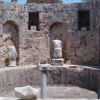 To the northwest of Manavgat are the remains of the ancient city of Seleukeia, situated within the Şıhlar settlement area. The city is known to have been founded as a fortified acropolis town to be used as a final defence and protection site in the case of an attack on Side. Upon the capture of Side by pirates in the 2nd century B.C., a number of the people immigrated to Seleukeia. The bronze statue of Apollon, understood to have been built during this era, is on display in the Antalya Museum. During the Pax Romana period acropolis cities eventually lost their former importance. The first of the remains are the city walls understood to have been built between two straits. It is understood that the walls were built at a height of 9 m, and the 5 m high city gate was located in the middle. There is a rectangular agora behind the gate. In the southeastern part of the Agora, is the odeon with 6 seating benches where, in addition to music concerts, the meetings of the administrative council of the city are held. In the northwestern part of the Agora, one can see a chapel with a single apsis with polygonal external apsis walls, understood to have been built during the Byzantine era. In the north of the Agora, 20 meters ahead, are the remains of a Temple of Apollon with a single cella and a marble podium. It is understood from the stones of ruined walls in front of the temple, that an inner wall was built as further protection from attacks involved during the periods that followed. On the western slope of the land, the remains of a sacred cave were found, in which baptism rituals were carried out in ancient times. This cave still holds drinking water even to this day. To the west of the cave, on the slope, are the remains of a Roman bathhouse complex with a mosaic-laid floor consisting of three main sections in the middle and various chambers at the sides. To the southwest of the bathhouse is a great basilica with coloured marble slabs on the floor under which sarcophagi are found.
To the northwest of Manavgat are the remains of the ancient city of Seleukeia, situated within the Şıhlar settlement area. The city is known to have been founded as a fortified acropolis town to be used as a final defence and protection site in the case of an attack on Side. Upon the capture of Side by pirates in the 2nd century B.C., a number of the people immigrated to Seleukeia. The bronze statue of Apollon, understood to have been built during this era, is on display in the Antalya Museum. During the Pax Romana period acropolis cities eventually lost their former importance. The first of the remains are the city walls understood to have been built between two straits. It is understood that the walls were built at a height of 9 m, and the 5 m high city gate was located in the middle. There is a rectangular agora behind the gate. In the southeastern part of the Agora, is the odeon with 6 seating benches where, in addition to music concerts, the meetings of the administrative council of the city are held. In the northwestern part of the Agora, one can see a chapel with a single apsis with polygonal external apsis walls, understood to have been built during the Byzantine era. In the north of the Agora, 20 meters ahead, are the remains of a Temple of Apollon with a single cella and a marble podium. It is understood from the stones of ruined walls in front of the temple, that an inner wall was built as further protection from attacks involved during the periods that followed. On the western slope of the land, the remains of a sacred cave were found, in which baptism rituals were carried out in ancient times. This cave still holds drinking water even to this day. To the west of the cave, on the slope, are the remains of a Roman bathhouse complex with a mosaic-laid floor consisting of three main sections in the middle and various chambers at the sides. To the southwest of the bathhouse is a great basilica with coloured marble slabs on the floor under which sarcophagi are found.